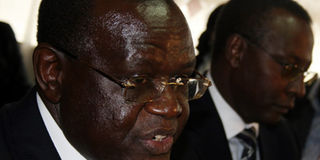Power cuts on the way, says Murungi

Energy minister Kiraitu Murungi during a news conference where he announced that Kenyans will soon face power rationing. He is with Kengen MD Eddy Njoroge. Photo/WILLIAM OERI
What you need to know:
- Power rationing set to begin on Thursday.
- Central Business Districts, hospitals, security installations and industrial areas throughout the country will have uninterrupted electricity supply.
Kenyans should brace themselves for power cuts as the government grapples with the energy crisis in the face of failed rains.
The power rationing move, set to begin on Thursday, comes as a severe blow to an already struggling economy after Energy minister Kiraitu Murungi announced that most parts of the country will go without electricity for hours for about two days a week.
Mr Murungi said only Central Business Districts, hospitals, security installations and industrial areas throughout the country will have uninterrupted electricity supply.
For security reasons there will, however, be no power supply disruptions at night, he said.
"In view of this serious power supply crisis, the Kenya Power and Lighting Company (KPLC) intends to introduce a power supply management programme with effect from August 6," Mr Murungi said.
The minister was accompanied by Energy permanent secretary Patrick Nyoike, KPLC managing director Joseph Njoroge and his KenGen counterpart, Eddy Njoroge.
The rationing follows reduced power generation due to reduced water inflows into major producing dams. Already, Kenyans are facing water rationing.
The country is already facing serious water and food shortages partly blamed to changing weather patterns as a result of destruction of forests and water catchments.
The power shortage is likely to adversely affect businesses and jobs and thus affect economic growth.
Mr Murungi said water inflows into the Masinga dam which is the holding reservoir for four power stations downstream has been the lowest ever since 1949. Masinga dam has since been closed for technical reasons.
As a result of drought, he added, power generation from the Tana River based power stations which account for 57 percent of the national power supply under normal weather has been scaled down by 60 percent.
"In other power stations down-stream (Kamburu, Kindaruma, Gitaru and Kiambere) electricity production has also been scaled down sharply to stretch the available water to October-November, when the short rains are expected," the minister said.
Although Western Kenya is not adversely affected by drought, hydro power production in Turkwel and Sondu has reduced by 25 and 60 per cent respectively.
Mr Murungi said the government is hoping the short-rains and el nino weather phenomena expected later in the year will result to adequate water inflows into the dams and improve generation capacity.
In the meantime, the government plans to import 1.25 million energy saving bulbs by September for free distribution in exchange for live inefficient ordinary bulbs to reduce power demand by 50 mega watts.
The new bulbs will costs Sh300 million, Mr Murungi said, adding that in future it will be mandatory for consumers to use the energy saving bulbs.
Other measures meant to address the shortage include commissioning of 26 MW of co-generation by Mumias Sugar Company by mid-August, a 15 MW thermal power by Iberafrica and a 89 MW one by Rabai Power Company.
"The above measures will provide an additional 270 MW to the national grid," Mr Murungi said.




